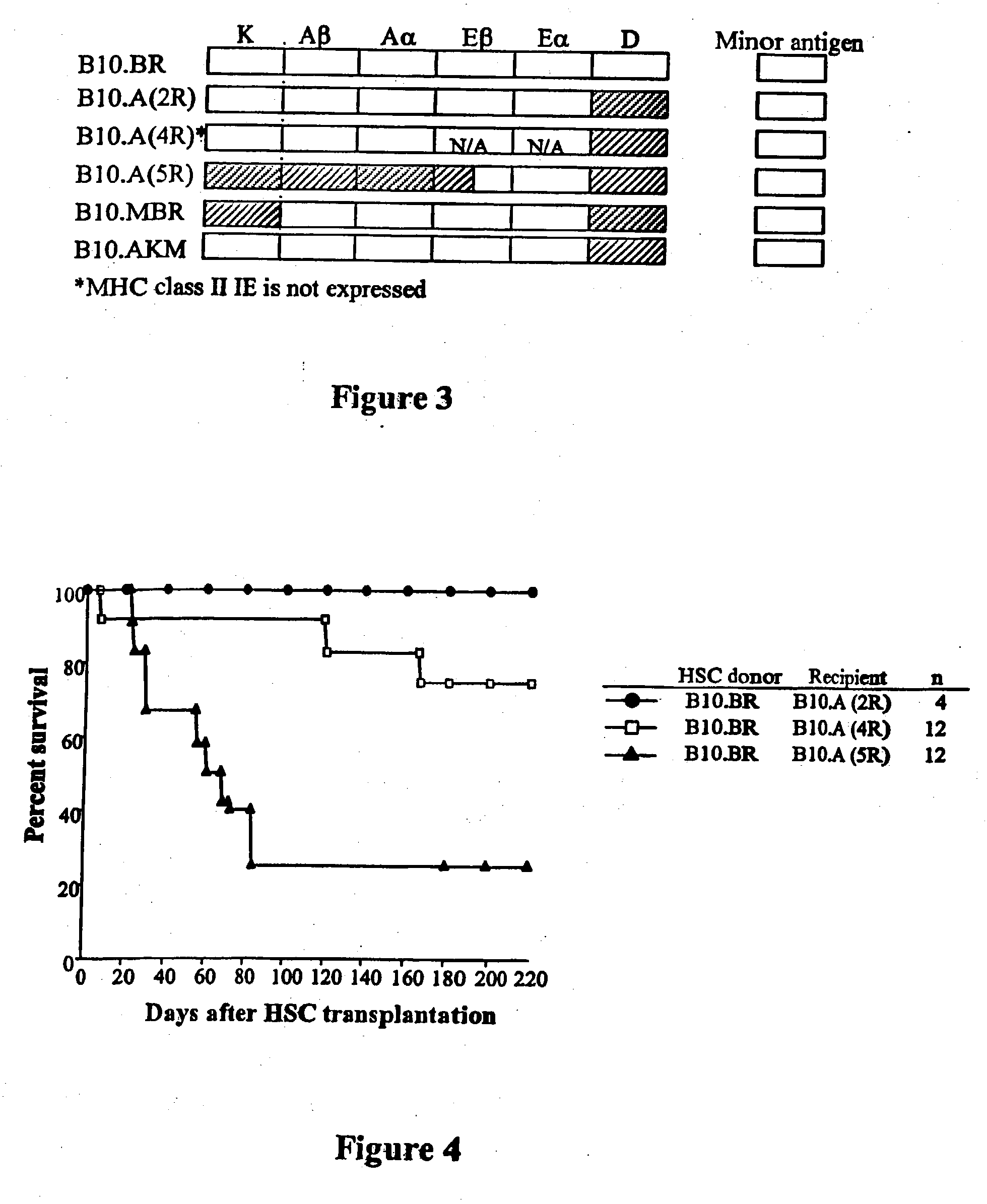Methods for enhancing engraftment of purified hematopoietic stem cells in allogeneic recipients
a technology of purified hematopoietic stem cells and allogeneic recipients, which is applied in the direction of anti-antibody medical ingredients, phosphorous compound active ingredients, therapy, etc., can solve the problems of increasing the susceptibility of recipients to infections and other diseases, increasing the rate of graft rejection, and a major source of morbidity and mortality, so as to achieve a higher rate of allogeneic hematopoietic stem cell engra
- Summary
- Abstract
- Description
- Claims
- Application Information
AI Technical Summary
Benefits of technology
Problems solved by technology
Method used
Image
Examples
example 1
Class I Matching is Critical to Engraftment of Purified HSC in Allogeneic Recipients
[0061] To determine which genetic loci are important to engraftment of HSC, recipient B10.BR, AKR, C57BL / 10, B10.A (2R), B10.A (4R), B10.A (5R) and B10, MBR mice were conditioned with 950 cGy and transplanted with 5000 Sca-1+ / c-kit+ / lineage− HSC from B10.BR donors (Table 1).
TABLE IMHC class I and class II loci between donor and recipient miceH-2 complexMouse strainKAβAαEβEαDMinor AntigenB10.BRkkkkkkMlsbAKRkkkkkkMlsaB10.MBRbkkkkqMlsbB10.A(2R)kkkkkbMlsbB10.A(4R)kkk / bk—*bMlsbB10.A(5R)bbb / kkkdMlsbC57BL / 10bbbk—*bMlsb
*Class II I-E is not expressed in this mouse strain
[0062] As expected, mice congeneic for MHC (B10.BR→B10.BR) (AKR→B10.BR) exhibited durable engraftment. In striking contrast, as shown in FIGS. 1 and 2 HSC provided short-term radioprotection but did not durably engraft MHC-disparate allogeneic recipients. Survival of recipients of allogeneic HSC alone was significantly prolonged compared w...
example 2
Facilitating Cells (CD8+ / TCR−) Enhance Engraftment of Allogeneic Hematopoietic Stem Cells: Importance of the MHC class I K Molecule
[0066] The facilitating cell is a rare CD8+ / TCR− / CD3ε+ cell in bone marrow that enhances engraftment of purified HSC in allogeneic recipients. To determine the role of FC in engraftment and self-renewal of purified HSC in MHC-disparate recipients, HSC and FC obtained from donors and recipients congenic at specific MHC loci were transplanted into MHC-disparate recipients.
[0067] As a control, 5000 HSC plus 30,000 FC from BIO.BR donors were transplanted into ablated recipients disparate at class I K and class II (B10.A5R); class I K and D (B10.MBR); and fully MHC-disparate (B10). B10.BR FC alone were transplanted as a control. As expected, recipients of FC alone expired at the time of radiation controls (MST=14 days) (Table 2).
TABLE 2Result of HSC plus FC Transplantation% Donor Chimerism (Mean + SD)Engraftment / Donor → Recipientn30 days60 days90 days120 ...
PUM
| Property | Measurement | Unit |
|---|---|---|
| resistance | aaaaa | aaaaa |
| synaptic strength | aaaaa | aaaaa |
| host resistance | aaaaa | aaaaa |
Abstract
Description
Claims
Application Information
 Login to View More
Login to View More - R&D
- Intellectual Property
- Life Sciences
- Materials
- Tech Scout
- Unparalleled Data Quality
- Higher Quality Content
- 60% Fewer Hallucinations
Browse by: Latest US Patents, China's latest patents, Technical Efficacy Thesaurus, Application Domain, Technology Topic, Popular Technical Reports.
© 2025 PatSnap. All rights reserved.Legal|Privacy policy|Modern Slavery Act Transparency Statement|Sitemap|About US| Contact US: help@patsnap.com



